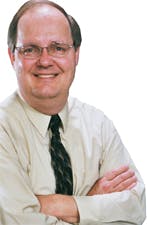I think we all have found someone in our careers whom we view as our number-one source of information for a particular topic. For me, Bud Trinkel was that guy when it came to fluid power circuits. Bud passed away about two months ago, and he knew more about circuits for hydraulic and pneumatic systems than anyone else I know. He knew all kinds of techniques and shortcuts to make circuits simpler, safer, less expensive, and more reliable.
Bud was also a big proponent of air logic. Air logic has been all but forgotten or never even heard of by most designers, even though many applications may still benefit from its use. Bud had devised many air logic circuits for indexing, sorting, and similar tasks that would be far more complicated and expensive if they used electronic controls and sensors. Granted, air logic has its limitations, but it also still has its place as a control. For example, the automatic shutoff feature of gasoline pumps uses air logic.
Anyway, I met Bud shortly after beginning my career on H&P more than 20 years ago. Bud contributed articles and taught seminars at our Hydraulics & Pneumatics Show, which has evolved into the Fluid Power Conference & Expo. When Bud cut back on his travel, he taught fluid power classes at a local Alcoa plant and began writing books.
Like many others in the fluid power industry, Bud was concerned about how most people designing fluid power circuits had not received proper training. But unlike most others, Bud decided to do something about it. He wrote a book called Fluid Power Basics, and followed that up with Fluid Power Circuits Explained. Both of these have become eBooks, which can be viewed and downloaded for free on our website. Bud wrote a third book, Troubleshooting Fluid Power Systems, which we also plan on turning into an eBook.
Bud was also the most prolific poster on our Fluid Power Forums. As with his books and consulting, Bud’s activity on our forums wasn’t a means to get rich; he truly was in it to help people. People would often post questions about how a hydraulic system was operating — or not operating — and Bud would answer the question and provide a detailed explanation of how the system worked so that the recipient would gain a greater understanding of fluid power systems.
Fortunately, Bud wasn’t the only person within the fluid power community I could lean on. I’m lucky enough to have a job where I can share what I learn from Bud and others like him through the magazine every month and in the thousands of pages we’ve archived on our website. Among the newest of these pages is Chapter 15 of Bud’s second eBook, Fluid Power Circuits Explained. So Bud may be gone from this Earth, but his contributions will continue to help others understand fluid power technology for years to come.
Alan Hitchcox
editor
[email protected]


